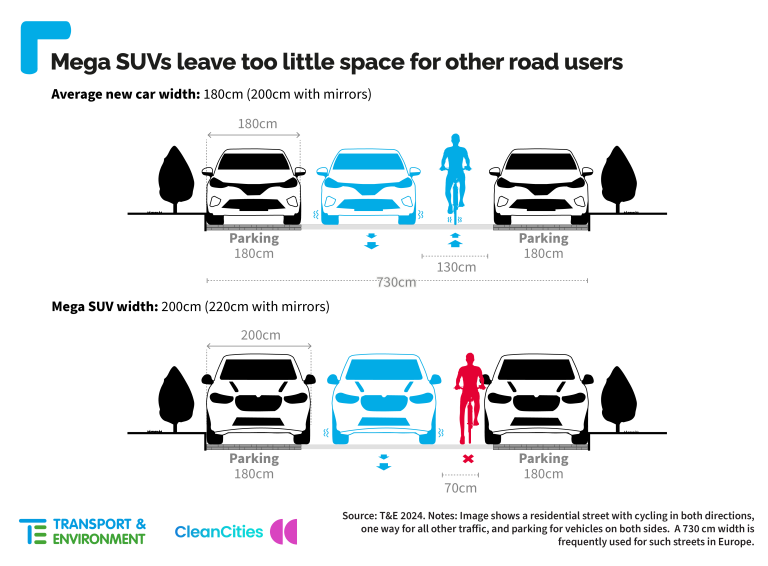Sign up for daily news updates from CleanTechnica on email. Or follow us on Google News!
Over half of new vehicles are too wide for many on-street parking spaces. Paris will vote on tripling parking fees for SUVs on 4 February.
New cars in Europe are getting 1 cm wider every two years, on average. That’s according to research by Transport & Environment (T&E) which says the trend will continue due to the rising sales of SUVs — unless lawmakers take action. Around half of new cars sold are already too wide for the minimum on-street parking space in many countries. Paris could be the first major European capital to tackle this trend if citizens endorse higher parking charges for SUVs in a referendum next month.
The average width of new cars expanded to 180.3 cm in the first half of 2023, up from 177.8 cm in 2018, the T&E research finds.[1] Data compiled by the ICCT confirms the same trend in the two decades up to 2020.[2] New cars in the EU are subject to the same maximum width, 255 cm, as buses and trucks. T&E said that unless the EU width limit for cars is reviewed and cities impose higher parking charges, large SUVs and pick-ups will continue to expand to the cap meant for trucks.
James Nix, Vehicles Policy Manager at T&E, said: “Cars have been getting wider for decades and that trend will continue until we set a stricter limit. Currently the law allows new cars to be as wide as trucks. The result has been big SUVs and American style pick-up trucks parking on our footpaths and endangering pedestrians, cyclists and everyone else on the road.”
Among the top 100 models in 2023, 52% of vehicles sold were too wide for the minimum specified on-street parking space (180 cm) in major cities, including London, Paris and Rome, the research also finds. Off-street parking is now a tight squeeze even for the average new car (180 cm wide), while large luxury SUVs no longer fit. Measuring around 200 cm wide, large luxury SUVs leave too little space for car occupants to get in and out of vehicles in typical off-street spaces (240 cm).
The growth in size is very pronounced among large luxury SUVs: in the most egregious cases, the Land Rover Defender grew by 20.6 cm and the Mercedes X5 by 6 cm in just six years. In 2023, Volvo went 4.1 cm wider with its EX90. Carmakers are using this growth of the largest SUVs to also increase the width of vehicles in the midsize and compact segments.

The trend towards wider vehicles is reducing the road space available for other vehicles and cyclists while parked cars are further encroaching on footpaths. The wider designs have also enabled the height of vehicles to be further raised, despite crash data showing a 10 cm increase in the height of vehicle fronts carries a 30% higher risk of fatalities in collisions with pedestrians and cyclists.[3]
Several European cities have already introduced more restrictive parking rules for SUVs.[4] The city of Paris is the latest and largest European city to tackle the trend of larger cars and has called citizens to vote on whether parking fees should be tripled for particularly heavy cars. A recent poll by the Clean Cities Campaign found that around two thirds of Parisians are in favour of higher parking fees for large, heavy and polluting vehicles.[5] If approved, new measures in the French capital would set an important precedent for many other European cities that are considering similar changes.
Barbara Stoll, Director of the Clean Cities Campaign, said: “Monster SUVs are a threat to the urban fabric of our cities. Unless we act now, more and more of our precious public space will be taken away from people by ever larger cars — this is not the cleaner, brighter and greener future that citizens want. On 4 February, Parisians have a unique opportunity to lead the way and say no to these polluting and dangerous giants taking over our streets.”
T&E said EU lawmakers should mandate a review of the maximum width of new cars when they update the legislation in the coming months.[6] Also, city authorities should set parking charges and tolls based on vehicle size and weight, so that large luxury SUVs and pick-ups pay more for using more space.
Spurred on by rising sales of large SUVs, newly-sold passenger vehicles (i.e. cars) are getting one centimetre wider every 2 years (see figure 1 below). All the indications are that this trend will continue without regulatory action by European law-makers. The current EU maximum width applied to all vehicles, 255 cm, was enacted to limit the expansion of buses and trucks in the mid 1990s — and was never truly intended for cars. The limit fails to contain the trend to ever-wider SUVs (including pick-up trucks), and there is a compelling case to review it.
The average width of new cars in the EU now exceeds 180 cm, and around half of sales now exceed this figure. 180 cm is a key threshold because it is a frequently-used minimum specification for the width of on-street parking in Europe. When parked in spaces 180 cm wide, vehicles exceeding this width simply don’t fit. Vehicles which exceed their parking bay take space from those using the footpath, from vehicles moving along the road, or from both the footpath and the road.
Troublingly, the ever-wider trend is continuing apace with large SUVs and pick-ups that approach or exceed 200 cm. The BMW X5 (200.4 cm), BMW X6 (200.4 cm), BMW X7 (200 cm), Mercedes Benz GLS (195.6 cm), Audi Q8 (199.5 cm), Porsche Cayenne (198.3 cm), Land Rover Defender (199.6 cm), Land Rover Range Rover Sport (199 cm), and VW Touareg (198.4 cm) are being joined by the Mercedes Benz EQS (195.9 cm), Volvo EX90 (196.4 cm), Kia EV9 (198 cm), and BMW XM (200.5 cm). The Dodge RAM, a top-selling American pick-up truck imported into Europe, measures up to 208.5 cm in width, overshooting 180 cm-wide parking spaces by almost 30 cm.
Reviewing the maximum width limit of light duty vehicles (cars, crossovers, SUVs, pick-ups and vans) is vital to protect public space from further encroachment, including footpaths, roadway and adjoining parking. Such a review must also consider the road safety risks posed by ever-wider SUVs, particularly since increased width enables the height of the vehicle to be further raised. Vehicle fronts raised by 10 cm carry a 30% higher risk of fatalities in collisions with pedestrians and cyclists.
Primarily this briefing makes the case for a review of light duty vehicle width by the European Commission, and calls for such a review as a matter of priority. To illustrate the background issues more deeply, we explore one scenario where new vehicles with a width in excess of the widest 3% of new sales today could no longer be newly-registered after a phase-in period. The 3% figure is an assumption used for illustrative purposes.
The widest 3% of new passenger car registrations in the first half of 2023 exceed 192.1 cm, and the scenario then assesses this figure as a potential revised maximum width, including its likely implications for electric vehicles.Because large vans, mini-buses and campervans (larger-volume vehicles) involve different use cases, the scenario explores a wider maximum of 207 cm for this cohort, with access to this higher limit governed by internal space thresholds. Potential application dates are also discussed. Overall, the scenario indicates that prompt action would deliver a crucial safeguard to arrest the ever-wider trend from becoming further embedded in future sales while having only modest market impact.
Crucially, decision-makers are urged to support the inclusion of a review clause to examine the maximum width of light duty vehicles in revising the Weights & Dimensions directive, being discussed in the European Parliament and Council in early 2024. Importantly: to support the inclusion of a review clause is not to specify new limits. Rather, it is to agree that the ever-wider trend warrants examination, and to entrust this examination to the European Commission within a defined timeframe.
[1] T&E compared the top 100 cars sold in 2018 to the top 100 in the first half of 2023.
[2] Average car width in the EU increased from 170.5 cm in 2001 to 180.2 cm in 2020. The International Council on Clean Transportation, European vehicle market statistics — Pocketbook 2021/22. Link.
[3] VIAS Institute (2023). Des voitures plus lourdes, plus hautes et plus puissantes pour une sécurité routière à deux vitesses ?Link. The 30% increase is based on vehicle fronts 90 cm high compared to 80 cm.
[4] The city of Lyon recently adopted higher parking costs for heavier vehicles, requiring SUVs to pay €15 more per month than an average car and €30 more than electric vehicles. Tübingen, Germany, has been applying a 50% mark-up on residential park charges since 2022. The association of German cities came out in support of higher parking charges based on the size of the vehicle.
[5] On February 4 2024, Paris is set to hold a referendum in which residents will be asked to vote on setting a specific parking tariff for heavy cars. The new rules would triple the price of parking (to €18 per hour in central districts, and €12 in other areas) but would not apply to Paris residents’ parking. The city organised a similar vote last year on the prohibition of shared electric scooters, following which it became the first European capital to impose such a ban. A survey for Clean Cities and Respire carried out by OpinionWay in January 2024 revealed that 61% of Parisians support the implementation of parking pricing by weight, a figure which rises to 70% if this measure is applied under conditions (revenues reinvested in the improvement of mobility in Paris, application to non-residential parking only, etc.).
[6] In the week of 12 February, the EU Parliament’s transport committee is expected to vote on an amendment to the Weights and Dimensions Directive that would mandate a review of the maximum width for new cars. The review clause would not specify new limits but would require the EU Commission to examine the issue. Page 145. Link.
Article first published on T&E website.
Have a tip for CleanTechnica? Want to advertise? Want to suggest a guest for our CleanTech Talk podcast? Contact us here.
Latest CleanTechnica TV Video
I don’t like paywalls. You don’t like paywalls. Who likes paywalls? Here at CleanTechnica, we implemented a limited paywall for a while, but it always felt wrong — and it was always tough to decide what we should put behind there. In theory, your most exclusive and best content goes behind a paywall. But then fewer people read it!! So, we’ve decided to completely nix paywalls here at CleanTechnica. But…
Thank you!
CleanTechnica uses affiliate links. See our policy here.




